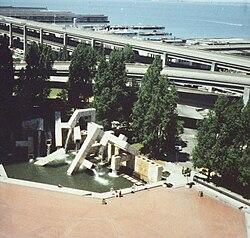In a striking turn of events, the artist responsible for the iconic Vaillancourt Fountain in San Francisco has issued a cease-and-desist letter aimed at halting plans for its destruction. Known for its distinctive design and emblematic place within the urban landscape, the fountain has long been a subject of debate among city officials and art advocates alike. As discussions about its future intensify, the letter from artist Armand Vaillancourt raises critical questions about artistic legacy, public space, and the value of cultural heritage in a rapidly changing city. This situation not only highlights the tension between urban development and artistic preservation but also underscores the significance of public art in shaping community identity. As stakeholders grapple with the fountain’s fate, this conflict brings to the forefront the vital role that artists play in preserving the heartbeat of our cities.
Artist Raises Concerns Over Preservation of Iconic Vaillancourt Fountain
The iconic Vaillancourt Fountain, a hallmark of San Francisco’s public art scene since its completion in 1971, is at risk following plans for redevelopment in the area. The fountain, a striking blend of contemporary design and kinetic water features, has drawn both admiration and criticism over the decades. However, the artist behind its creation, Armand Vaillancourt, has taken a firm stand, sending a cease-and-desist letter to city officials to prevent what he deems as an unjustifiable destruction of his work. In the letter, he emphasizes the fountain’s historical significance and its role in the cultural tapestry of the city, arguing that its removal would represent not only a loss of artistic expression but also a neglect of San Francisco’s commitment to preserving its diverse artistic heritage.
In his correspondence, Vaillancourt outlines several compelling reasons for the fountain’s preservation, including:
- Artistic Integrity: The fountain reflects a unique artistic vision that contributes to the landscape of public sculptures in the city.
- Cultural Significance: As a prominent piece of public art, it serves as a gathering place and a symbol of community identity.
- Historical Context: The fountain is part of the larger narrative of San Francisco’s urban development and artistic movements of the late 20th century.
Despite these arguments, discussions around urban renewal continue, leading to a contentious dialogue among city officials, residents, and art advocates. The future of the Vaillancourt Fountain remains uncertain, as the administrative decision-making process weighs the value of historical art against modern infrastructure needs.
Legal Action Sparks Debate on Public Art Accountability
The recent cease-and-desist letter sent by the artist behind the iconic Vaillancourt Fountain in San Francisco has ignited a heated discussion surrounding the responsibilities artists have to their public works after creation. The move comes amid plans for the fountain’s demolition, a decision the artist deems as an affront not just to his work but also to the broader implications for public art preservation. This situation has raised critical questions regarding the accountability of city officials and the rights of artists over their creations, especially in a city renowned for its dedication to cultural heritage. As advocates and critics alike converge on the issue, the discourse surrounding public funding, artistic expression, and community engagement continues to evolve.
Supporters of the fountain argue that its unique design and historical significance should ensure its protection, while detractors claim that maintenance concerns and urban development outweigh preservation efforts. The debate is further complicated by various stakeholders, including local government agencies, community members, and art historians who all bring their perspectives to the table. Points for consideration include:
- The historical context of the artwork: Understanding its role in the city’s narrative.
- Artistic integrity vs. civic responsibility: Balancing the artists’ intentions with community needs.
- Public engagement: The need for dialogue about community preferences in public art management.
Community Urged to Advocate for Cultural Heritage Amid Ongoing Disputes
The recent cease-and-desist letter issued by the artist behind San Francisco’s iconic Vaillancourt Fountain highlights the ongoing battle over cultural heritage within urban spaces. As tensions escalate surrounding the future of this beloved public artwork, the broader community has been urged to step forward and advocate for the preservation of artistic and cultural landmarks. The situation reflects a growing concern over how cities balance modernization with the safeguarding of cultural identity, making it a pivotal moment for advocates of public art and heritage.
Community members are encouraged to take several proactive measures to support cultural heritage in the face of these disputes, including:
- Raising Awareness: Organize discussions and workshops to inform the public about the importance of preserving cultural landmarks.
- Engaging with Local Government: Attend city council meetings to voice support for the protection of artistic sites.
- Building Coalitions: Form alliances with local artists, historians, and residents to strengthen advocacy efforts.
- Utilizing Social Media: Launch campaigns to share stories and significance of cultural heritage sites like the Vaillancourt Fountain.
| Action | Description |
|---|---|
| Awareness Campaigns | Educational initiatives to highlight cultural significance. |
| Public Demonstrations | Rallies to showcase community support for preservation. |
| Media Outreach | Engaging local media to cover the importance of heritage sites. |
In Summary
In light of the ongoing dispute surrounding the Vaillancourt Fountain, the artist’s cease-and-desist letter underscores the complexities involved in preserving public art amidst urban development. As stakeholders weigh the fountain’s artistic significance against the backdrop of changing city landscapes, the future of this iconic installation remains uncertain. With public sentiment and legal proceedings both playing pivotal roles in the ongoing dialogue, it becomes increasingly clear that the fate of the Vaillancourt Fountain will serve as a crucial test case for the preservation of artistic heritage in an era marked by rapid transformation. The outcome of this situation not only affects the fountain itself but could also set important precedents for how cities navigate the intersection of art, culture, and urban planning in the years to come. As developments continue to unfold, the art world and local communities will undoubtedly be watching closely.









